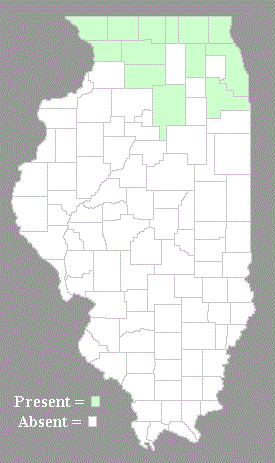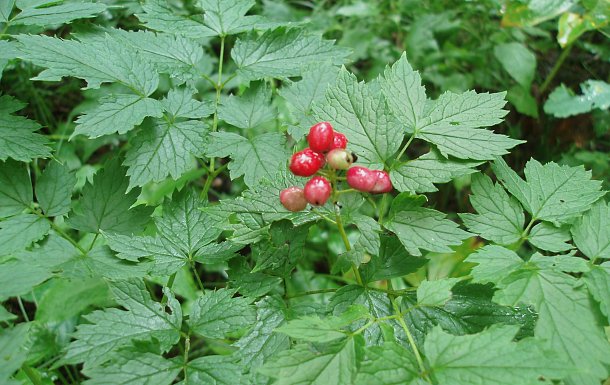
The central stem and any secondary stems terminate in solitary racemes of flowers that are 1-2" long; these racemes become slightly longer when the flowers are replaced by berries. Each flower is about ¼" across or slightly wider, consisting 4-10 white petals, several inconspicuous sepals, 15-40 white stamens, and a pistil. The petals are widely spreading and narrowly elliptic in shape, while the stamens are long and showy. The style of the pistil is very short or absent, while the stigma of the pistil is short and stout. The ascending to widely spreading pedicels are up to ½" long (or slightly more) and they are noticeably more slender than the rachis (central stalk) of the raceme. The peduncle (basal stalk) of each raceme is up to 4" long. The blooming period occurs during late spring or early summer, lasting about 3 weeks. The flowers have a rosy fragrance. Afterwards, fertile flowers are replaced by ovoid berries that become 6-8
 mm. long at
maturity. These berries are usually bright red and glossy at maturity,
although there is a less common form of this plant that has white
berries. Each berry contains a fleshy pulp and several seeds.
Individual seeds are 3.0–3.5 mm. long, reddish brown, and wedge-shaped.
The root system consists of a vertical rootstock with fibrous secondary
rootlets below.
mm. long at
maturity. These berries are usually bright red and glossy at maturity,
although there is a less common form of this plant that has white
berries. Each berry contains a fleshy pulp and several seeds.
Individual seeds are 3.0–3.5 mm. long, reddish brown, and wedge-shaped.
The root system consists of a vertical rootstock with fibrous secondary
rootlets below.Cultivation: The preference is light to moderate shade, moist to mesic conditions, and a somewhat acidic soil consisting of sandy loam, loam, or clay-loam with decaying organic matter. The soil should contain abundant nitrogen, calcium, and other nutrients. The seeds are slow to germinate, typically taking 2 years or more under natural conditions. This plant prefers cool moist weather and it is winter hardy to at least Zone 4.
Range & Habitat: The native Red Baneberry occurs in northern Illinois, where it is uncommon. Illinois lies along the southern range-limit of this species. Habitats include moist to mesic woodlands, shady stream banks, and shaded areas where some seepage of ground water occurs. In Illinois, this plant is found in high quality natural areas where either deciduous trees or a mixture of deciduous trees and conifers occur. North of the state, it also occurs in conifer forests. Red Baneberry is able to survive occasional wildfires.
Faunal Associations: The flowers of Red Baneberry attract miscellaneous beetles, flies, and to a lesser extent Halictid bees (Pellmyr, 1985). Only pollen is available as a floral reward. Some vertebrate animals feed on the fruits or seeds of this plant. Examples of birds that eat the fruits include the Ruffed Grouse, Yellow-bellied Sapsucker, American Robin, Wood Thrush, Gray-cheeked Thrush, Brown Thrasher, and Catbird. Examples of small mammals that eat the seeds (while usually rejecting the pulp) include the Woodland Deer Mouse, White-footed Mouse, Eastern Chipmunk, Red Squirrel, and Red-backed Vole (Crane, 1990; Martin et al., 1951/1961; Hamilton, 1941). Because the foliage is somewhat toxic, it is usually avoided by mammalian herbivores. All parts of this plant, including the fruit, are toxic to humans.
Photographic Location: A woodland in Lake County, Illinois. The photographs were taken by Paul Showers (Copyright © 2015).

Comments: Because of its attractive foliage, flowers, and bright red berries, Red Baneberry (Actaea rubra) is an excellent selection for cool shade gardens. It is similar in appearance to Doll's Eyes (Actaea pachypoda), except the latter species always has white berries. When Red Baneberry produces white berries, it can be distinguished from Doll's Eyes by its more slender pedicels (basal stalklets of the flowers or berries). The pedicels of Doll's Eyes are nearly as thick as the rachis (central stalk) of the floral raceme. Doll's Eyes tends to have longer racemes, but this distinction is not always reliable. The latter species can be found throughout Illinois.